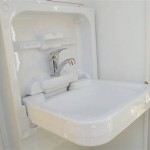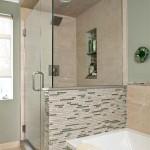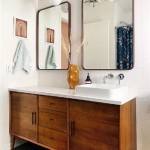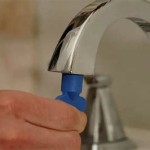Wall-Mounted Bathroom Sink Shelf Design: Functionality and Aesthetics
Wall-mounted bathroom sink shelves have become increasingly popular in modern bathroom design. They offer a unique combination of space-saving functionality and visual appeal, making them a desirable choice for both small and large bathrooms. This article delves into the various aspects of wall-mounted bathroom sink shelf design, exploring the materials, styles, installation considerations, and benefits that contribute to their widespread adoption.
The primary purpose of a wall-mounted bathroom sink shelf is to provide storage and counter space without occupying valuable floor space. Traditional vanity cabinets can often feel bulky and restrictive, especially in smaller bathrooms. A wall-mounted shelf provides an open and airy feel, making the bathroom appear larger and more accessible. This design choice also simplifies cleaning, as there is no cabinet base resting on the floor, eliminating the accumulation of dust and debris underneath.
The aesthetic value of a wall-mounted sink shelf is equally significant. They are available in a wide variety of materials, finishes, and styles, allowing homeowners to customize their bathroom to match their personal preferences. From rustic wood shelves to sleek, minimalist glass designs, the options are nearly limitless. The exposed plumbing beneath the shelf can also be incorporated into the overall design, adding an industrial or modern touch with the use of decorative pipes and fittings.
Material Selection and its Impact
The choice of material for a wall-mounted bathroom sink shelf significantly influences its durability, appearance, and overall functionality. Several materials are commonly used, each with its own distinct advantages and disadvantages.
Wood is a popular choice for its natural warmth and versatility. Solid wood shelves, such as oak, maple, or walnut, offer exceptional strength and longevity. These wood types are naturally water-resistant to some extent but require proper sealing and finishing to prevent damage from moisture and humidity. Engineered wood products, such as plywood or MDF (Medium-Density Fiberboard), are more affordable alternatives. However, they are less resistant to moisture and may require more extensive sealing and waterproofing measures. When using wood in a bathroom setting, it is crucial to select a water-resistant finish, such as polyurethane or varnish, to protect the wood from water damage and warping.
Stone is another durable and aesthetically pleasing option. Materials like granite, marble, and quartz offer excellent resistance to water, stains, and heat. Stone shelves are typically more expensive than wood or glass options, but their durability and luxurious appearance justify the investment for many homeowners. Stone is relatively heavy and necessitates robust mounting hardware to ensure stability and safety.
Glass shelves provide a clean and minimalist aesthetic. Tempered glass is the preferred choice for bathroom applications due to its strength and safety. In the event of breakage tempered glass shatters into small, relatively harmless pieces, reducing the risk of injury. Glass shelves are easy to clean and maintain and are resistant to water and stains. However, they can be prone to scratching and may require more frequent cleaning to remove water spots and fingerprints. The transparent nature of glass can also showcase the plumbing beneath the sink, which may or may not be desirable depending on the overall design aesthetic.
Metal shelves, typically constructed from stainless steel or powder-coated steel, offer a modern and industrial look. Stainless steel is highly resistant to corrosion and rust, making it an excellent choice for a bathroom environment. Powder-coated steel provides a durable and attractive finish that can be customized in various colors. Metal shelves are strong and easy to clean but can be prone to scratching if not properly protected. The cold and sterile appearance of metal may not appeal to all homeowners, but it can be effectively combined with other materials, such as wood or glass, to create a more balanced and inviting design.
Style Considerations for a Cohesive Bathroom Design
The style of a wall-mounted bathroom sink shelf should complement the overall design of the bathroom. A variety of styles are available, ranging from traditional to contemporary, and selecting the right style is crucial for achieving a cohesive and visually appealing space.
For traditional bathrooms, wood shelves with ornate detailing and classic hardware are often a suitable choice. A natural wood finish, such as cherry or mahogany, can enhance the warmth and elegance of the space. Pairing the shelf with a traditional-style sink and faucet can further reinforce the overall aesthetic.
In modern bathrooms, minimalist designs with clean lines and simple shapes are typically preferred. Glass or metal shelves with a sleek, unadorned design can create a sense of spaciousness and sophistication. A white or neutral color palette can further enhance the minimalist aesthetic.
Rustic bathrooms can benefit from the use of reclaimed wood shelves with a distressed finish. The natural imperfections and character of reclaimed wood can add warmth and charm to the space. Pairing the shelf with a farmhouse-style sink and vintage-inspired hardware can complete the rustic look.
Industrial-style bathrooms often incorporate metal shelves with exposed pipes and fittings. A dark metal finish, such as black or bronze, can create a raw and edgy aesthetic. Combining the shelf with a concrete or brick backsplash can further reinforce the industrial feel.
Beyond the overall style, the shape and size of the shelf should also be considered. Rectangular shelves are a common choice, but other shapes, such as curved or asymmetrical designs, can add visual interest. The size of the shelf should be appropriate for the size of the sink and the amount of storage space required.
Installation and Structural Integrity
Proper installation is crucial for ensuring the safety and stability of a wall-mounted bathroom sink shelf. The shelf must be securely attached to the wall to support the weight of the sink, plumbing, and any items placed on it. This necessitates a careful assessment of the wall structure and the use of appropriate mounting hardware.
The first step in the installation process is to locate the wall studs. Wall studs are vertical framing members that provide structural support. A stud finder can be used to locate the studs behind the drywall or plaster. Mounting the shelf directly to the wall studs is the most secure method of installation. If wall studs are not conveniently located, it may be necessary to use wall anchors to provide additional support.
Several types of wall anchors are available, each with its own load-bearing capacity. Toggle bolts are a strong and reliable option for mounting heavy items to drywall. They consist of a bolt with a spring-loaded wing that expands behind the wall, providing a secure hold. Molly bolts are another type of anchor that expands as the bolt is tightened, creating a tight grip on the wall. Plastic wall anchors are suitable for lighter loads but should not be used for supporting heavy sinks or shelves.
Before installing the shelf, it is essential to carefully measure and mark the mounting locations. A level should be used to ensure that the shelf is installed straight and even. Pilot holes should be drilled before inserting the mounting screws to prevent the wood from splitting. When installing a stone or glass shelf, it is important to use appropriate mounting hardware that will not damage the material. Rubber or plastic washers can be used to protect the shelf from scratches and cracks.
The plumbing connections for the sink must also be carefully considered during the installation process. The drainpipe and water supply lines must be properly connected to prevent leaks. Flexible supply lines can be used to simplify the installation process and allow for greater flexibility in positioning the sink. A P-trap should be installed in the drainpipe to prevent sewer gases from entering the bathroom. The plumbing connections should be thoroughly inspected for leaks after the installation is complete.
In addition to the structural and plumbing considerations, it is also important to ensure that the shelf is installed at the appropriate height. The standard height for a bathroom sink is typically between 30 and 34 inches from the floor. However, the ideal height may vary depending on the height of the users. It is important to consider the comfort and accessibility of all users when determining the installation height.
Finally, after the installation is complete, the shelf should be thoroughly inspected to ensure that it is stable and secure. Any loose screws or connections should be tightened. The plumbing connections should be checked for leaks. The shelf should be able to support the weight of the sink and any items placed on it without sagging or wobbling.

Clever Idea For Storage Under A Wall Mounted Sink Home Decor Bathroom Organization

Pin On Remodeling Idears

Small Bathroom Secret Free Up Space With A Wall Mounted Sink

How To Install A Bathroom Sink Floating Shelf Durovin

23 Wall Mounted Floating Vanity Cabinet Ideas Sebring Design Build Bathroom Sinks Small Vanities

Arezzo Stone Resin Wall Mounted Basin Shelf 600mm Wide Matt White Victorian Plumbing

Mc 1600h 63 Wall Mounted Vanity With Shadow Box Shelf

35 Smart Bathroom Organization Ideas Small Storage Design Trendy

Serene Valley Bathroom Floating Vanity 32 Wall Mount Sink With Side

Arezzo Stone Resin Wall Mounted Basin Shelf 1200mm Wide Matt White Victorian Plumbing
Related Posts







